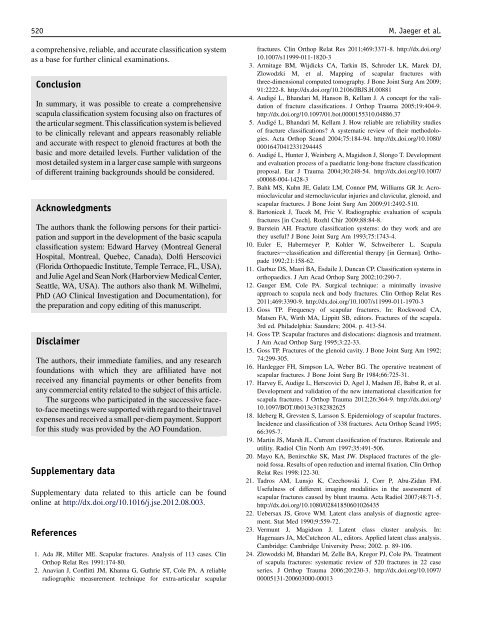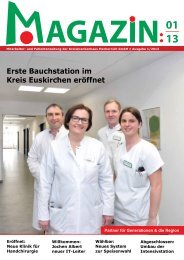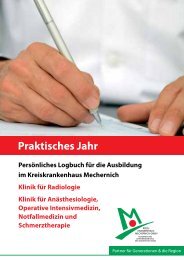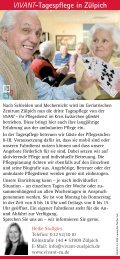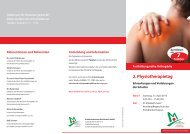scapula fracture classification system - Kreiskrankenhaus Mechernich
scapula fracture classification system - Kreiskrankenhaus Mechernich
scapula fracture classification system - Kreiskrankenhaus Mechernich
Create successful ePaper yourself
Turn your PDF publications into a flip-book with our unique Google optimized e-Paper software.
520 M. Jaeger et al.<br />
a comprehensive, reliable, and accurate <strong>classification</strong> <strong>system</strong><br />
as a base for further clinical examinations.<br />
Conclusion<br />
In summary, it was possible to create a comprehensive<br />
<strong>scapula</strong> <strong>classification</strong> <strong>system</strong> focusing also on <strong>fracture</strong>s of<br />
the articular segment. This <strong>classification</strong> <strong>system</strong> is believed<br />
to be clinically relevant and appears reasonably reliable<br />
and accurate with respect to glenoid <strong>fracture</strong>s at both the<br />
basic and more detailed levels. Further validation of the<br />
most detailed <strong>system</strong> in a larger case sample with surgeons<br />
of different training backgrounds should be considered.<br />
Acknowledgments<br />
The authors thank the following persons for their participation<br />
and support in the development of the basic <strong>scapula</strong><br />
<strong>classification</strong> <strong>system</strong>: Edward Harvey (Montreal General<br />
Hospital, Montreal, Quebec, Canada), Dolfi Herscovici<br />
(Florida Orthopaedic Institute, Temple Terrace, FL, USA),<br />
and Julie Agel and Sean Nork (Harborview Medical Center,<br />
Seattle, WA, USA). The authors also thank M. Wilhelmi,<br />
PhD (AO Clinical Investigation and Documentation), for<br />
the preparation and copy editing of this manuscript.<br />
Disclaimer<br />
The authors, their immediate families, and any research<br />
foundations with which they are affiliated have not<br />
received any financial payments or other benefits from<br />
any commercial entity related to the subject of this article.<br />
The surgeons who participated in the successive faceto-face<br />
meetings were supported with regard to their travel<br />
expenses and received a small per-diem payment. Support<br />
for this study was provided by the AO Foundation.<br />
Supplementary data<br />
Supplementary data related to this article can be found<br />
online at http://dx.doi.org/10.1016/j.jse.2012.08.003.<br />
References<br />
1. Ada JR, Miller ME. Scapular <strong>fracture</strong>s. Analysis of 113 cases. Clin<br />
Orthop Relat Res 1991:174-80.<br />
2. Anavian J, Conflitti JM, Khanna G, Guthrie ST, Cole PA. A reliable<br />
radiographic measurement technique for extra-articular <strong>scapula</strong>r<br />
<strong>fracture</strong>s. Clin Orthop Relat Res 2011;469:3371-8. http://dx.doi.org/<br />
10.1007/s11999-011-1820-3<br />
3. Armitage BM, Wijdicks CA, Tarkin IS, Schroder LK, Marek DJ,<br />
Zlowodzki M, et al. Mapping of <strong>scapula</strong>r <strong>fracture</strong>s with<br />
three-dimensional computed tomography. J Bone Joint Surg Am 2009;<br />
91:2222-8. http://dx.doi.org/10.2106/JBJS.H.00881<br />
4. Audige L, Bhandari M, Hanson B, Kellam J. A concept for the validation<br />
of <strong>fracture</strong> <strong>classification</strong>s. J Orthop Trauma 2005;19:404-9.<br />
http://dx.doi.org/10.1097/01.bot.0000155310.04886.37<br />
5. Audige L, Bhandari M, Kellam J. How reliable are reliability studies<br />
of <strong>fracture</strong> <strong>classification</strong>s? A <strong>system</strong>atic review of their methodologies.<br />
Acta Orthop Scand 2004;75:184-94. http://dx.doi.org/10.1080/<br />
00016470412331294445<br />
6. Audige L, Hunter J, Weinberg A, Magidson J, Slongo T. Development<br />
and evaluation process of a paediatric long-bone <strong>fracture</strong> <strong>classification</strong><br />
proposal. Eur J Trauma 2004;30:248-54. http://dx.doi.org/10.1007/<br />
s00068-004-1428-3<br />
7. Bahk MS, Kuhn JE, Galatz LM, Connor PM, Williams GR Jr. Acromioclavicular<br />
and sternoclavicular injuries and clavicular, glenoid, and<br />
<strong>scapula</strong>r <strong>fracture</strong>s. J Bone Joint Surg Am 2009;91:2492-510.<br />
8. Bartonicek J, Tucek M, Fric V. Radiographic evaluation of <strong>scapula</strong><br />
<strong>fracture</strong>s [in Czech]. Rozhl Chir 2009;88:84-8.<br />
9. Burstein AH. Fracture <strong>classification</strong> <strong>system</strong>s: do they work and are<br />
they useful? J Bone Joint Surg Am 1993;75:1743-4.<br />
10. Euler E, Habermeyer P, Kohler W, Schweiberer L. Scapula<br />
<strong>fracture</strong>sd<strong>classification</strong> and differential therapy [in German]. Orthopade<br />
1992;21:158-62.<br />
11. Garbuz DS, Masri BA, Esdaile J, Duncan CP. Classification <strong>system</strong>s in<br />
orthopaedics. J Am Acad Orthop Surg 2002;10:290-7.<br />
12. Gauger EM, Cole PA. Surgical technique: a minimally invasive<br />
approach to <strong>scapula</strong> neck and body <strong>fracture</strong>s. Clin Orthop Relat Res<br />
2011;469:3390-9. http://dx.doi.org/10.1007/s11999-011-1970-3<br />
13. Goss TP. Frequency of <strong>scapula</strong>r <strong>fracture</strong>s. In: Rockwood CA,<br />
Matsen FA, Wirth MA, Lippitt SB, editors. Fractures of the <strong>scapula</strong>.<br />
3rd ed. Philadelphia: Saunders; 2004. p. 413-54.<br />
14. Goss TP. Scapular <strong>fracture</strong>s and dislocations: diagnosis and treatment.<br />
J Am Acad Orthop Surg 1995;3:22-33.<br />
15. Goss TP. Fractures of the glenoid cavity. J Bone Joint Surg Am 1992;<br />
74:299-305.<br />
16. Hardegger FH, Simpson LA, Weber BG. The operative treatment of<br />
<strong>scapula</strong>r <strong>fracture</strong>s. J Bone Joint Surg Br 1984;66:725-31.<br />
17. Harvey E, Audige L, Herscovici D, Agel J, Madsen JE, Babst R, et al.<br />
Development and validation of the new international <strong>classification</strong> for<br />
<strong>scapula</strong> <strong>fracture</strong>s. J Orthop Trauma 2012;26:364-9. http://dx.doi.org/<br />
10.1097/BOT.0b013e3182382625<br />
18. Ideberg R, Grevsten S, Larsson S. Epidemiology of <strong>scapula</strong>r <strong>fracture</strong>s.<br />
Incidence and <strong>classification</strong> of 338 <strong>fracture</strong>s. Acta Orthop Scand 1995;<br />
66:395-7.<br />
19. Martin JS, Marsh JL. Current <strong>classification</strong> of <strong>fracture</strong>s. Rationale and<br />
utility. Radiol Clin North Am 1997;35:491-506.<br />
20. Mayo KA, Benirschke SK, Mast JW. Displaced <strong>fracture</strong>s of the glenoid<br />
fossa. Results of open reduction and internal fixation. Clin Orthop<br />
Relat Res 1998:122-30.<br />
21. Tadros AM, Lunsjo K, Czechowski J, Corr P, Abu-Zidan FM.<br />
Usefulness of different imaging modalities in the assessment of<br />
<strong>scapula</strong>r <strong>fracture</strong>s caused by blunt trauma. Acta Radiol 2007;48:71-5.<br />
http://dx.doi.org/10.1080/02841850601026435<br />
22. Uebersax JS, Grove WM. Latent class analysis of diagnostic agreement.<br />
Stat Med 1990;9:559-72.<br />
23. Vermunt J, Magidson J. Latent class cluster analysis. In:<br />
Hagenaars JA, McCutcheon AL, editors. Applied latent class analysis.<br />
Cambridge: Cambridge University Press; 2002. p. 89-106.<br />
24. Zlowodzki M, Bhandari M, Zelle BA, Kregor PJ, Cole PA. Treatment<br />
of <strong>scapula</strong> <strong>fracture</strong>s: <strong>system</strong>atic review of 520 <strong>fracture</strong>s in 22 case<br />
series. J Orthop Trauma 2006;20:230-3. http://dx.doi.org/10.1097/<br />
00005131-200603000-00013


